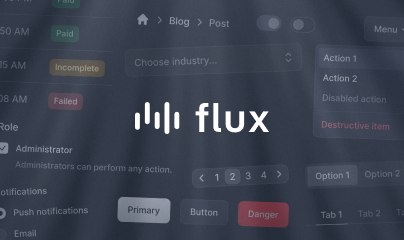Layout
The #[Layout] attribute specifies which Blade layout a full-page component should use, allowing you to customize layouts on a per-component basis.
Basic usage
Apply the #[Layout] attribute to a full-page component to use a specific layout:
<?php // resources/views/pages/posts/⚡index.blade.php use Livewire\Attributes\Layout;use Livewire\Attributes\Computed;use Livewire\Component;use App\Models\Post; new #[Layout('layouts::dashboard')] class extends Component { #[Computed] public function posts() { return Post::all(); }};?> <div> <h1>Posts</h1> @foreach ($this->posts as $post) <div wire:key="{{ $post->id }}">{{ $post->title }}</div> @endforeach</div>This component will render using the resources/views/layouts/dashboard.blade.php layout instead of the default.
Default layout
By default, Livewire uses the layout specified in your config/livewire.php file:
'layout' => 'layouts::app',The #[Layout] attribute overrides this default for specific components.
Passing data to layouts
You can pass additional data to your layout using array syntax:
new #[Layout('layouts::dashboard', ['title' => 'Posts Dashboard'])] class extends Component { // ...};In your layout file, the $title variable will be available:
<!DOCTYPE html><html><head> <title>{{ $title ?? 'My App' }}</title></head><body> {{ $slot }}</body></html>Alternative: Using layout() method
Instead of the attribute, you can use the layout() method in your render() method:
<?php // resources/views/pages/posts/⚡index.blade.php use Livewire\Component; new class extends Component { public function render() { return view('livewire.posts.index') ->layout('layouts::dashboard', ['title' => 'Posts']); }};The attribute approach is cleaner for single-file components that don't need a render() method.
Using different layouts per page
A common pattern is to use different layouts for different sections of your app:
// Admin pagesnew #[Layout('layouts::admin')] class extends Component { } // Marketing pagesnew #[Layout('layouts::marketing')] class extends Component { } // Dashboard pagesnew #[Layout('layouts::dashboard')] class extends Component { }When to use
Use #[Layout] when:
- You have multiple layouts in your application (admin, marketing, dashboard, etc.)
- A specific page needs a different layout than the default
- You're building a full-page component (not a regular component)
- You want to keep layout configuration close to the component definition
The #[Layout] attribute only applies to full-page components. Regular components that are rendered within other views don't use layouts.
Learn more
For more information about full-page components and layouts, see the Pages documentation.
Reference
#[Layout( string $name, array $params = [],)]| Parameter | Type | Default | Description |
|---|---|---|---|
$name |
string |
required | The name of the Blade layout to use |
$params |
array |
[] |
Additional data to pass to the layout |
